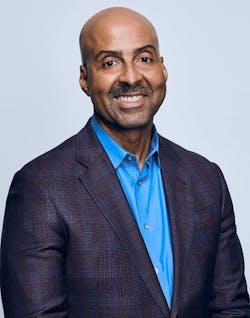AT&T’s CFO says it does not need an acquisition to scale its fiber business
AT&T is confident that it can continue to scale its fiber broadband business without acquiring an asset from another provider.
Speaking during the Bank of America Media, Communications, and Entertainment Conference, AT&T’s CFO Pascal Desroches said that the company has fully developed its organic fiber expansion plan.
“Our ambitions regarding fiber are significant, and we are well on our way,” he said. “We don’t need to do a transaction to gain scale.”
His comments come after fellow ILEC Verizon announced earlier that morning that it would acquire Frontier for $20 billion to enhance its fiber broadband and fixed and mobile wireless services base.
Led by T-Mobile and now Verizon with its proposed acquisition of Frontier, there’s been a flurry of acquisition activity in the fiber broadband industry segment.
However, Desroches emphasized that it plans to stick with a plan through the build-out of its fiber assets.
“When I think about our all-in costs to pass a home location, I would much instead build and generate the returns of building versus going out and buying an asset and paying a premium,” he said. “This affirms the strategy we laid out four years ago, and we’re happy others are following along.”
Expansion on track
AT&T maintains that it is on track with its fiber deployment plans.
As of the end of the second quarter, the service provider reached nearly 28 million consumer and business locations and expects to surpass 30 million locations by the end of 2025. The provider also has a complementary 5G wireless network.
Its efforts are certainly paying off. As of the end of the second quarter, AT&T had 239,000 AT&T Fiber net subscribers during the second quarter, marketing over 200,000+ net adds for 18 consecutive quarters.
“We have invested in spectrum and fiber and now are at 28 million locations passed and are well on our way to 30 million by the end of next year,” Desroches said.
Another factor is its ambition to reach more locations independently and through AT&T’s Gigapower initiative.
Gigapower focuses on an open-access model that will initially pass 1.5 million homes nationwide, enabling multiple fiber-to-the-home service providers to use and share the network. AT&T will use the Gigapower network to offer fiber broadband services outside its established territories.
“We have identified 10-15 million locations in our footprint before our Gigapower investment,” Desroches said.
While AT&T has no immediate plans to acquire another provider to scale its fiber footprint, it recognizes that deals like Verizon’s and others reflect the growing need for fiber-based broadband.
“When you look at bandwidth consumption trends, they are going up significantly,” Desroches said. “Ultimately, the provider who has networks at scale in both wireless and fiber will be the ones who will succeed.”
Enhancing wireless/wireline convergence
Like Verizon and other providers that have a wireless asset, AT&T sees the opportunity to provide converged services.
AT&T is well down the convergence road already. It has seen lower customer turnover in markets where it delivers fiber and wireless.
“Fiber is a product that our customers love,” Desroches said. “Having fiber paired with wireless, we see considerable churn reduction in fiber and wireless as well.”
Additionally, in markets where it offers fiber broadband today, AT&T’s wireless penetration rises.
“In markets where we have fiber, we have 500 basis point advantage in terms of penetration relative to our overall nationwide penetration,” Desroches said. “The benefits are considerable.”
He added that it “does not mean you can’t sell fiber or wireless by itself, but the benefits of convergence are powerful, and we have a long runway to add more converged subscribers, and we’re building fiber every day.”
As traditional telcos scale their fiber broadband networks, they need a weapon to challenge cable’s long-standing broadband lead.
Comcast and Charter have suffered broadband losses to fiber and fixed wireless in recent quarters. Comcast had 120,000 broadband subscribers during the second quarter, while Charter lost 154,000.
Jeff Heynen, VP at Dell’Oro, said that if telcos sense that fiber and convergence are the ticket to ending cable’s dominance in the US, scaling your network and fiber footprint is the best way to take advantage of this shift in subscriber preference.”
For related articles, visit the Business Topic Center.
For more information on high-speed transmission systems and suppliers, visit the Lightwave Buyer’s Guide.
To stay abreast of fiber network deployments, subscribe to Lightwave’s Service Providers and Datacom/Data Center newsletters.

Sean Buckley
Sean is responsible for establishing and executing the editorial strategies of Lightwave and Broadband Technology Report across their websites, email newsletters, events, and other information products.


